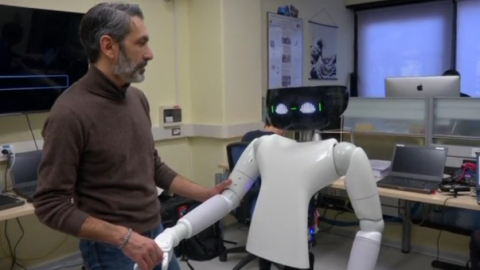
GENOA, Italy (Reuters) — Roboticists from the Italian Institute of Technology (IIT) are developing a new type of automaton to help out around the home; one that will cost the equivalent of a small car.
Demand for service robots is expected to accelerate in the next three years as robots – already used to perform tasks such as assisting medical surgery, milking cows or moving objects around warehouses – become more popular for domestic and personal use.
R1 is the first robot built by IIT specifically designed for applications in domestic and professional environments.
Project leader Giorgio Metta said that a crucial design consideration with R1 was having sufficient dextrous ability to perform basic handling and manipulating tasks.
While it R1 doesn’t have individual fingers, its hands are in the shape of two articulated graspers and can lift weights up to 1.5kg and completely close around objects like bottles and cups.
“This is a service robot, so it’s been designed for assistance, for personal assistance. So it has to be able to manipulate objects, at least to grasp them and move them around. So you’d be able to ask for something like a glass of water and the robot should be able to grasp it and bring it to you,” Metta told Reuters at the IIT lab in Genoa.
“We think it’s crucial for the ability to grasp and manipulate. There are very few robots that can do that at a cost that is affordable,” he added.
While still at the prototype stage, R1’s hands and forearms will eventually be covered with an artificial skin with built-in sensors to enable it to “feel” the interaction with the objects they manipulate. On the current prototype, just a section of the robot’s right forearm has the sensitive material.
“These parts are sensitive to touch. So the robot can understand interaction with people,” said Metta.
R1’s face has two stereo cameras and a 3D scanner, and is made from a color LED screen capable of various ‘expressions’ for non-verbal communication with humans. To help the wheeled robot stay upright and maintain its orientation, it has an accelerometer and a gyroscope.
Service robots, which perform tasks useful for humans and are often mobile, are distinguished from industrial robots, which are used in automated manufacturing on factory floors.
One potential market that many domestic robot makers have looked to crack is assistive devices for people with disabilities.
“It’s estimated that over 20 percent of the population have some form of disability,” said Barry Sawyer, a British disability emploment advisor.
“Many of these would benefit from an assistive robot. This could be people, from someone with a mobility impairment to dexterity issues, or even someone with autism or dementia might need assistance with care or social skills.”
While the prohibitive cost of robots has largely prevented widespread adoption so far, it may also have something to do with their target market, added Sawyer.
“It’s partly because the technology is quite new at the moment, and lots of disabled people tend to be older. So perhaps there’s some resistance to disabled people actually having a robot because it’s quite a new concept,” he said.
Sales of humanoid robots as human companions for everyday tasks have until now not been significant, after the first ones were shipped in 2004 to international laboratories and universities for research and development.
The IIT team’s iCub humanoid robot was built to support research in embodied artificial intelligence (AI). About 30 iCubs have been built and are used in research centers in Europe, the United States, Korea and Japan. Each iCub costs a quarter-of-a-million euros.
Metta said the cost of a fully-functioning domestic robot along the lines of the iCub is too prohibitive. R1, he says, will be much, much cheaper.
“Our initial iCub stills costs 250,000 (euros), which is too much for mass production. This one (the R1) is ten times cheaper to start with. So we envisage at the beginning business applications, so these could be robots for a shopping mall, for a hospital, for an airport,” he said.
“When we eventually manage to hit the consumer market this will be at the price of maybe 4-5 thousand (euros), so reasonably affordable,” added Metta.
Global turnover of service robots – which include robots that can mow the lawn or clean windows – is forecast to increase to about $46 billion in the 2016-2019 period, compared with about $7 billion in 2015, according to a 2016 report by the International Federation of Robotics.
Metta added that with the involvement of private investors, IIT will begin large scale production of R1 later this year.







